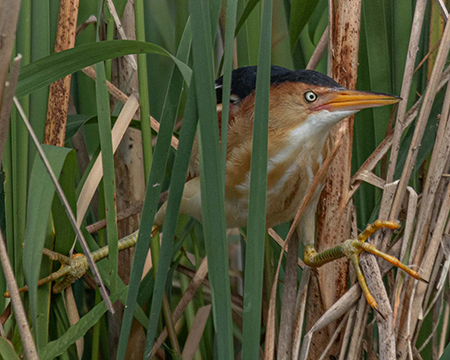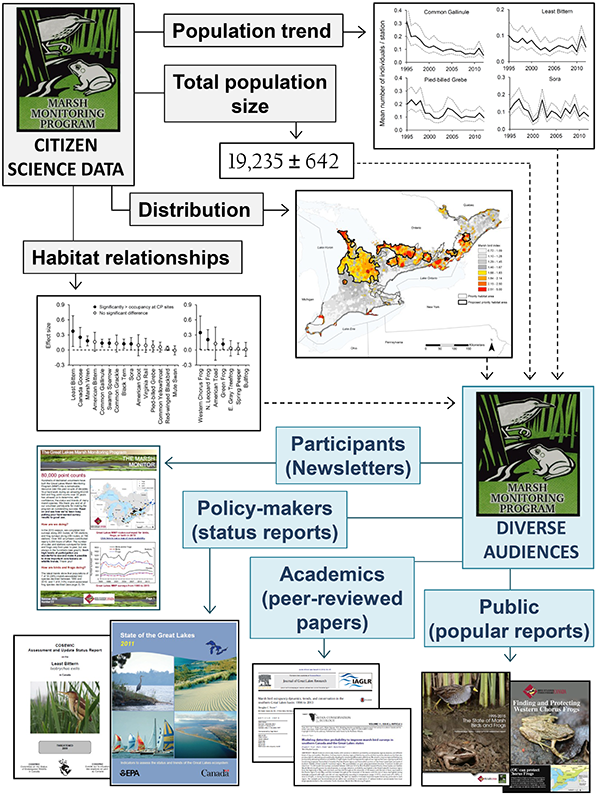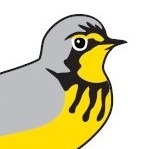By Dr. Doug Tozer (Director, Waterbirds and Wetlands) and Kathy Jones (Volunteer Manager, Ontario Program), Bird Studies Canada
It’s astonishing: 1764 Citizen Scientists have surveyed marsh birds and/or frogs at some point over the past 25 years as part of the Great Lakes Marsh Monitoring Program. The program began in Ontario in 1994, went binational in 1995, and has since grown to become a hallmark of trusted information on wetland wildlife in the Great Lakes. We find it amazing and are extremely thankful that so many people have donated so much time to make this program a success.
The program’s Citizen Scientists have logged 152,748 hours (equivalent to 6365 days or 17.4 years) while collecting and entering data, which is equivalent to about 3 million dollars of donated time! While putting in all of those hours, they completed 93,658 marsh bird and frog point count surveys, plus nearly 25,000 habitat assessments. All of the effort captured a remarkable 446,898 bird and frog occurrence records of over 300 species.

Least Bittern Photo: Gilles Bisson
These contributions have accomplished a great deal for advancing wetland conservation. Each year, we fulfill dozens of data requests made by partner organizations for use in biodiversity assessment, wetland restoration and protection, climate change research, environmental assessment prior to development, educational and experiential learning, and species at risk planning and mapping. Bird Studies Canada staff also use the data to report on the health of wetland bird and frog communities, assess populations of species at risk, and develop science tools for the Great Lakes Restoration Initiative and the Ontario Eastern Habitat Joint Venture – arguably the most influential forces achieving on-the-ground wetland restoration, protection, and conservation throughout the Great Lakes. In a previous blog post, we outlined the outcomes and science products produced by the program and the audiences that we aim to reach with them. See the graphic below for a summary.
Each of these outcomes benefits wetlands, wetland wildlife, and people. So please join us in giving a heartfelt thank-you to all of our Great Lakes Marsh Monitoring Program Citizen Scientists. You have done, and continue to do, a great service for the conservation of marsh birds, frogs, and wetlands.
For the latest marsh bird and frog population trends, program accomplishments, and other Great Lakes Marsh Monitoring Program news, check out the 2019 issue of the Marsh Monitor. And for more information on the program, including reports and articles, click here.
Bird Studies Canada appreciates the support of the Great Lakes Marsh Monitoring Program by: Environment and Climate Change Canada, United States Environmental Protection Agency, Ducks Unlimited Canada, Eastern Habitat Joint Venture, Government of Ontario, Great Lakes Restoration Initiative, John and Pat McCutcheon Charitable Foundation, Kenneth M. Molson Foundation, TD Friends of the Environment Foundation, US Fish and Wildlife Service, and Wildlife Habitat Canada. We also gratefully acknowledge past support from: Brant Waterways Foundation, Great Lakes Commission, Great Lakes Protection Fund, Great Lakes Sustainability Fund, Great Lakes United, National Audubon Society, Ontario Trillium Foundation, and Wetland Habitat Fund.

The Great Lakes Marsh Monitoring Program produces a number of science products (shown in grey at the top), which Bird Studies Canada staff then work hard to share with different audiences (show in light blue at the bottom). Ultimately, all of these approaches lead to positive impacts on the ground.

